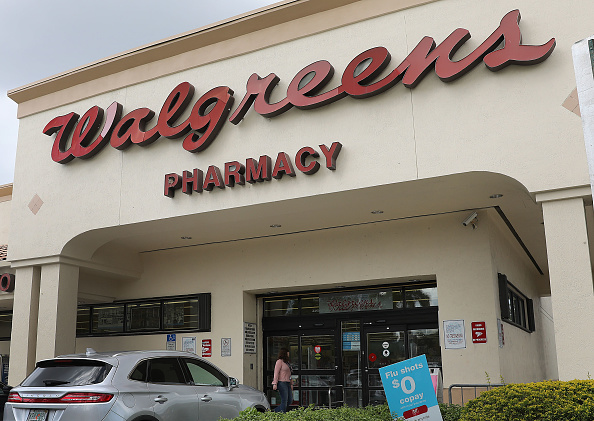begin quote from:
https://medcitynews.com/2024/07/walgreens-pharmacy-healthcare-retail/
Walgreens’ Finances Are in Dire Straits — But All Hope Is Not Lost
Walgreens’ financial performance is still rocky, but experts agree there is a good chance that CEO Tim Wentworth can lead the company to recovery. To make this happen, Walgreens will have to let go of its retail clinic dreams and focus more on making its core pharmacy business as strong as possible.

What is going on at Walgreens?
If you’re someone who has followed the healthcare stock market over the past few years, there’s a good chance you have asked that question. The Illinois-based pharmacy giant’s stock price has decreased by 80% in the past five years — currently trading at about $11 per share, compared to about $56 in July 2019.
The company’s trademark red cursive “W” is becoming less and less ubiquitous across the nation’s street corners, too. During an earnings call June 27, Walgreens CEO Tim Wentworth revealed plans to shut down a quarter of the company’s 8,600 U.S. stores by 2027.
In the three months that ended May 31, the firm’s revenue inched up to $36.4 billion, a 2.6% increase compared to the same quarter a year ago. The company also reported a net income of $344 million, up from $118 million during the same period in 2023. Walgreens’ revenue and profitability numbers may be better than they were a year ago, but there are strong headwinds in the U.S. pharmacy world.
The company’s near term guidance doesn’t inspire too much confidence — during an earnings call two weeks ago, the company narrowed its adjusted earnings-per-share even further to between $2.80 and $2.95 per share.
The company declined to provide responses to MedCity News’ questions about why the company’s stock price has dropped so dramatically and how it plans to get itself back on track, referring all commentary to the earnings call held two weeks ago.
Experts from across the healthcare industry agree that while Walgreens is currently in a grim financial situation, recovery is still possible. To make this happen, the company will have to relinquish its retail clinic dreams and focus more on making its core pharmacy business as efficient as it can. This journey seems to have already begun, given Walgreens announced earlier this year that it will close 160 of its VillageMD primary care clinics.

What Healthcare Can Learn from Costco
The path forward is clear: employers must evaluate their health plan the same way they do their Saturday shopping excursion.
Here’s how Stephanie Davis, senior equity research analyst at Barclays, summarized her take on Walgreens’ situation.
“Looking ahead, while we think management is taking the right strategic steps within U.S. healthcare (we believe VillageMD represents the largest margin drag across [Walgreens’] assets), we see a continued challenging macro backdrop and profitability headwinds in U.S. retail pharmacy that likely overshadow execution, supporting our [underweight or sell] rating [on the stock],” she wrote in her equity research report following Walgreens’ recent quarterly earnings call.
Business troubles in the front and back of the store
Walgreens is suffering from issues in both the front of the store and back of the store, said Peter Ax, CEO of UpScriptHealth, a company that fills prescriptions online through telehealth visits.
“In the front of the store, theft has forced them to place products behind locked plastic covers which requires calling an employee to open it for the consumer. Staff shortages and poor quality labor have made this an impossible business model — especially while there are firms like Amazon with immediately available inventory that can deliver within a day, and sometimes within hours,” Ax explained.
He pointed out that the front of the store is also being affected by supply chain issues and a high level of cost consciousness among consumers — two issues that have lingered since the pandemic.
In the back of the store, Walgreens is battling reduced margins. Ax believes this is attributable to pressure from lower-priced generics offered by firms like Mark Cuban’s Cost Plus Drugs, as well as rising usage of pharmacy discount cards, such as those provided by GoodRx.
He implied that slow revenue growth will hamper Walgreens’ ability to invest in new technologies that may set it apart from its competitors. Ax noted that there is an increased demand for pharmacists to act as care coordinators, which means they have to spend a lot of time answering questions from patients and giving health advice instead of filling prescriptions, therefore affecting revenue.
“We graduate approximately 14,000 pharmacists annually and current demand is likely several times that number,” he declared. “Dispensing pharmacies need to invest in innovative technologies and automation, but that requires capital. The current cost of capital will impact Walgreens’ ability to invest in and reinvent and reconfigure stores.”
Have our retail health dreams been dashed?
In 2021 and 2022, there was a good deal of excitement about how retail health clinics could increase access to care and create value in terms of improved downstream outcomes and cost savings. That fundamental opportunity still remains, but the execution has proven to be challenging, noted Rebecca Springer, lead private equity analyst at PitchBook.
“Building de novo primary care clinics is an extremely capital intensive way to scale care delivery — this has always been the case, for all players and not just retailers, but the markets have become less forgiving,” she said.
Additionally, the benefits that some imagined for locating primary care in retail spaces have not materialized quickly enough, Springer pointed out. These include using pharmacists as part of the primary care team, engaging patients who were otherwise disengaged with the healthcare system, and utilizing consumer data to shape population health and care management strategy, she explained.
Walgreens isn’t the only one struggling to keep its retail health efforts afloat, though — Amazon threw in the towel on its hybrid primary and urgent care business nearly two years ago, and CVS Health began shuttering dozens of its pharmacies in Target stores this year. Just two months ago, Walmart announced plans to close all 51 of its primary care clinics as well as its virtual care business.
Springer said she is keeping a close eye on Oak Street Health and One Medical, which she called “the last primary care plays standing.”
A leader from the traditional healthcare provider space — John Couris, CEO of Tampa General Hospital — highlighted another key reason that retailers are struggling in the care delivery arena.
“Healthcare providers benefit from steep discounts and other wholesale benefits because of their high patient volumes — retailers can’t tap into those and therefore, struggle to find profitability in this space,” Couris stated.
He also noted that retail clinics’ care coordination is often poor.
Say a patient sees a retail health provider in the clinic or via telehealth, and then they find out that they need specialized care. The patient still needs to find a doctor at a health system to deliver that care, and when they do, their records usually don’t follow them to their new provider’s EHR, Couris explained.
Essentially, retail clinics don’t have much of an incentive to share data, so they often don’t. In Couris’ view, the aspect of the retail health model perpetuates a major problem in the healthcare world: episodic and poorly connected care.
Will things start to improve with a new leader at the helm?
To help turn its business back around, Walgreens welcomed Wentworth as its new CEO in October following the departure of its former leader, Rosalind Brewer.
In his first seven months of the job, Wentworth seems to be focused on rightsizing the cost structure of Walgreens’ business, declared Keonhee Kim, healthcare equity analyst at Morningstar.
This is evidenced by the fact that the company slashed its dividend by nearly half in January, as well as its recent announcement that it is closing 25% of all U.S. stores by 2027, Kim noted.
“I think managing costs and focusing on key profitable markets is a good strategy, but the near-term future of [Walgreens] remains uncertain,” he said.
Another healthcare leader — Hal Andrews, CEO of market research firm Trilliant Health — pointed out that Wentworth appears to have concluded that Walgreens needs to return to its pharmacy and retail roots. He thinks it is a good thing that Walgreens is retreating from the primary care space while simultaneously expanding in specialty pharmacy presence through its Shields Pharmacy Solutions subsidiary.
During the earnings call at the end of June, Wentworth stated that Walgreens’ financial turnaround will be driven by “disciplined cost management at VillageMD, along with strength at Shields.”
The firm announced a move to strengthen its core pharmacy business in April, detailing plans to deepen its specialty pharmacy offerings to include cell and gene therapy services.
“The phrase ‘everything has been on the table’ that Wentworth used on the earnings call is how a CEO describes a review of anything and everything that their predecessors did, and Wentworth clearly questions the strategy of his recent predecessors — with the exception of the acquisition of Shields,” Andrews commented.
Can Walgreens bounce back?
To Andrews, Walgreens is too big to fail.
He believes the company’s most daunting obstacle to streamlining its retail portfolio will be protests from local officials and residents in the communities affected by the upcoming store closures. Andrews has faith that Wentworth can weather these challenges, given his track record of successful leadership at the helm of Express Scripts and Evernorth.
Andrews noted that Wentworth’s most revealing comment during the earnings call was, “Actually, pharmacy is the value-based healthcare provider in the ecosystem, quite frankly, if you really look at cost for outcomes and the work that we can do to impact those outcomes.”
In other words, pharmaceutical interventions hold immense value for patients, often more so than hands-on care delivered by health systems, he explained. Take obesity treatment for example — in the emerging battle between hands-on care and pharmaceutical innovations, Ozempic and Mounjaro are positively impacting people’s lives more than bariatric surgery is, Andrews declared.
Ax, of UpScriptHealth, also has faith that Walgreens will recover. How quickly the company will be able to turn things around depends on how aggressive Wentworth and the rest of his leadership team decide to be in the coming months when it comes to cost cutting and switching focus, he said.
“The problem CEOs make when companies are failing is they don’t act sufficiently bold. Walgreens’s recent investor call would lead you to believe they know they are in a critical moment and that they need to make dramatic changes. We will soon know whether or not they make those changes,” Ax stated.
Wentworth has the respect of the investor community, which should give him enough flexibility to enact a multi-quarter business restructuring plan, Ax said. In his view, this plan should focus initially on investing in automation and other infrastructure technologies to support pharmacy fulfillment, as well as partnering with digital health companies to increase prescription volume.
This plan also needs to focus on shuttering underperforming stores and repurposing stores with expensive leases, Ax added.
“Leases on many Walgreens stores may make them too expensive to close, so [Wentworth] should consider making some retail locations automated distribution centers acting as ‘closed door pharmacies,” he said.
Ax noted that Wentworth has “an excellent track record for quickly understanding problems and reinventing a path to success, saying he “would not bet against” the new Walgreens CEO.
If the Wentworth Walgreens reinvention succeeds, Wall Street may reward the stock.
Photo credit: Joe Raedle, Getty Images


No comments:
Post a Comment